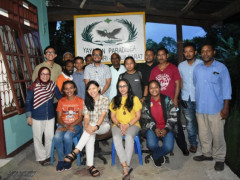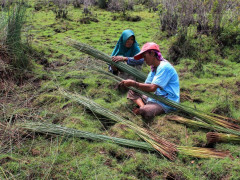West Papua Regional Meeting
By Simpul Jaringan Pantau Gambut Papua BaratPreserve Peat, Save Biodiversity from the Threats of Ecological Disaster

Recently, the flooding occurring in several areas in West Kalimantan has been greatly reported in local and national mass media. A resident reportedly died due to the flooding in Melawi District. Floods submerged nearly 1,000 houses in Kapuas Hulu District and 8 Sub-Districts in Sintang District. Flooding also occurred in 10 villages in Landak District and 5 Sub-Districts in Mempawah District.
There have been two floods in five districts in the last 2-3 months. Floods also hit 22 villages in two sub-districts of the Ketapang District last June. Floods occur as rainfall increases in West Kalimantan. The river overflows and the land became inundated.
The Meteorology, Climatology, and Geophysical Agency (BMKG) predicts that the intensity and frequency of rain will increase compared to last year. The increase in sea surface temperature and humidity in the atmosphere as well as the wind patterns will result in rainfall that is above average. The intensity and frequency of rain are also predicted to increase in September.
Based on the Indonesian Forum for the Environment (Walhi) records, West Kalimantan, Melawi, Sintang, and Kapuas Hulu are flood-prone areas. Other flood-prone areas are Mempawah, Hedgehog, Ketapang, and several other areas in West Kalimantan. Flooding could occur more than once a year in these areas. The increase in rainfall is only a trigger and not the main cause of flooding in West Kalimantan. The impact from increased rain intensity and frequency can be overcome or at least minimized if the ecosystem balance is maintained.
The fact is that the water catchment areas in West Kalimantan are becoming increasingly critical. Forest areas are shrinking due to encroachment and land conversion.
Walhi West Kalimantan has inventoried approximately 13.31 million out of the 14.86 million hectares of watershed (DAS) areas in West Kalimantan that have been degraded due to exploitation. Approximately 1.34 million hectares are in very critical condition and 2.10 million hectares are in critical condition. On the other hand, approximately 6.14 million hectares are in near-critical condition and 3.73 million hectares are in potentially critical condition. Therefore, only 1.55 million hectares or approximately 10.43% of the watershed areas in West Kalimantan are in good condition. The 2011 research results could at least illustrate the ecosystem damage in West Kalimantan.
Forest conversion and illegal gold mining activities are the main causes of watershed damage in West Kalimantan. Both of these activities resulted in silting and erosion, which causes the river channel to narrow and unable to accommodate the overflowing rainwater.
Most of the watershed areas are peatlands, hence they could cause drought and are prone to fires during the dry season. This is also relevant to our previous monitoring results. Walhi West Kalimantan estimates that at least 20% of the companies with oil palm plantation permit occupies the peat areas. This change of functions can cover hundreds of hectares in one location.
Peat ecological function
West Kalimantan is a province with the fourth largest peat area in Indonesia, which is approximately 1.72 million hectares. This is equivalent to 11.8% of the total area of West Kalimantan (14.68 million hectares). Peatlands are spread along the coast all the way to the upstream areas in West Kalimantan’s primary watersheds. These primary watersheds are the Kapuas watershed, the Mempawah watershed, the Sambas watershed, and the Pawan watershed. The average peat thickness in these areas is approximately 4 meters.
Peat has the ability to store water, hence it can prevent flooding during the rainy season and drought during the dry season. Peat functions like a sponge or water reservoir. The peat hydrological function can be disrupted or even completely neutralized due to changes in natural vegetation, drainage construction, and land burning. Drainage construction makes the peat layers dry quickly, hence it drastically reduced the peat’s ability to absorb water.
The decreased function of the peat due to changes in the landscape and construction of drainage not only results in a localized impact but also a more widespread impact. The reduced peat volume has increased the chance of flooding. Likewise, it also increases the chances of a fire occurring during the dry season. The One Million Hectare Peatland Development Project in Central Kalimantan is a concrete example of a fatal error made in peat ecosystem management. Excessive drainage has made the former project site a source of flooding as well as a producer of haze. Drought during the dry season has also exacerbated the decreasing water levels in a number of rivers in Central Kalimantan.
Climate change
The thickness of peat in Indonesia ranges between 0.5 meters to more than 10 meters. One meter of peat stores approximately 400-700 tons of carbon per hectare, hence Indonesia is estimated to have approximately 300 to more than 6,000 tons of carbon stocks from every hectare of peatland.
If you refer to the peat distribution map, Indonesia is estimated to have 27 Gigatonnes of carbon reserves from the peatlands. That is assuming that approximately 14.9 million hectares of peat have an average depth of 3 meters. However, the peatlands’ carbon dioxide is released into the atmosphere at an increasing rate due to land conversion, drainage construction or canals, as well as forest and land fires. Dissolved carbon is also washed away by water in the peat canals.
The peat, which should absorb carbon, instead emits carbon dioxide emissions. Carbon dioxide is the largest greenhouse gases contributor in the world. The United Nations (UN) report states that carbon dioxide accounts for more than 60% of the global warming causes, which in turn has affected climate change
The United Nations Development Program (UNDP) has reported the El Nino and La Nina storms, which have caused extreme weather to occur more frequently in Indonesia. The El Nino is due to the rising sea temperatures in the Pacific Ocean, which resulted in a long dry season. On the other hand, La Nina occurred due to a decrease in sea temperature, which increases rainfall and makes it prone to flooding. Tropical cyclones are also reported to occur more frequently, which causes strong winds and heavy rains that can last for days in Indonesia.
The recent increase in the frequency and intensity of rain in West Kalimantan is exacerbated by the reduced number of water catchment areas, which includes the peat areas. The land conversion activities along with forest and land fires have made a number of peatlands in critical condition.
Land fires rapidly degrade the peat ecological function, because it not only scorches the vegetation and peat layers but also disrupts the entire ecosystem. Based on several scientific studies, forest and land fire damages and destroy plant seeds that are located on the surface or buried in the soil. Opportunities for the local native vegetation species to grow and regenerate are also very limited.
Therefore, without belittling the condition of the flood victims, this disaster can be used as a momentum to reflect and make changes. We must try to maintain and restore the peat functions to their previous state. We hope the policymakers will consistently implement, monitor, and enforce the regulations, so this flood will be the last ecological disaster in West Kalimantan. (*)
*The author is the Executive Director of Walhi West Kalimantan and Coordinator of Simpul Jaringan Pantau Gambut - West Kalimantan.
** THIS WRITING WAS PREVIOUSLY PUBLISHED IN THE PONTIANAK POST OPINION COLUMN ON 28 SEPTEMBER 2020 AND THE PONTIANAK POST PRINTED MEDIA OPINION COLUMN ON PAGE 2 ON 29 SEPTEMBER 2020 **



